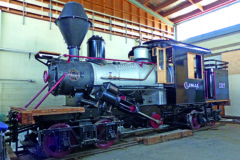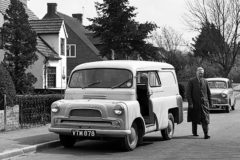1956 Austin A35 Pick-up
Posted by Chris Graham on 23rd February 2021
Even the owner of this beautifully-restored 1956 Austin A35 pick-up can’t help but wonder why the model was ever built. Nick Larkin tells the story.
Photography: Matt Richardson

Harry Douglas’ beautifully-restored 1956 Austin A35 Pick-up in full flight.
If ever there was an award for the world’s cutest classic pick-up, Harry Douglas would surely – and without question – be taking home the prize cup for his deeply rare, 1956 Austin A35 Pick-up. The curvy, tiny and chubby body, immaculate in its historically-accurate Austin service livery would, wherever this machine was parked, guarantee a crowd of admirers making coo-ing noises.
Even your average modern Dodge Ram or Mitsubishi Warrior would show this vehicle respect. The sight of this little Austin blasts us back to the days of proper local garages when, following a stern ‘fill her up, please’, a gentleman in a brown house coat would carefully replenish your tank and clean the windscreen, while a spotty apprentice continued decoking a pre-war Seven’s cylinder head in the shed. Evocative stuff, but however rose-tinted this vehicle makes our spectacles, we can only speculate over why Austin decided to build it.
A mystery decision
The reason has never been fully explained, but there must have been a meeting in which senior management said: ‘OK everyone, let’s do it!’ Handshakes all round. As pick-up owner Harry suggests: “You have to wonder what they’d had for lunch the day the pick-up got the got the go-ahead; it’s a strange vehicle!”

Harry’s pick-up is part of a collection, and another pick-up project is, apparently, waiting in the wings.
So, let’s marshal the evidence. The Austin A35 range was introduced in 1956, as a development of the massively successful Austin A30; Austin’s first, unitary-construction small car, introduced at the 1951 Earls Court Motor Show. The saloon had been joined by the Countryman estate in 1953, and the van from 1954, with both continuing as A35s.
The A35 featured the 948cc, rather than the 803cc version of Austin’s A-series engine, which gave a lot more power and torque. The transmission was also upgraded, and a shorter, ‘remote-control’ gear change was installed. The car received a larger back window and body colour – rather than chrome – featured on the radiator grille.
The pick-up entered the fray in 1956, being basically a saloon with much of the rear roof removed, and a tiny loading area. We can only wonder at why Austin didn’t simply modify its 5cwt A35 van to make a pick-up version instead? Maybe the idea of the newcomer was to complement the forthcoming, larger, half-ton A55 commercial, meaning there was a range of sizes for Austin dealers to sell.
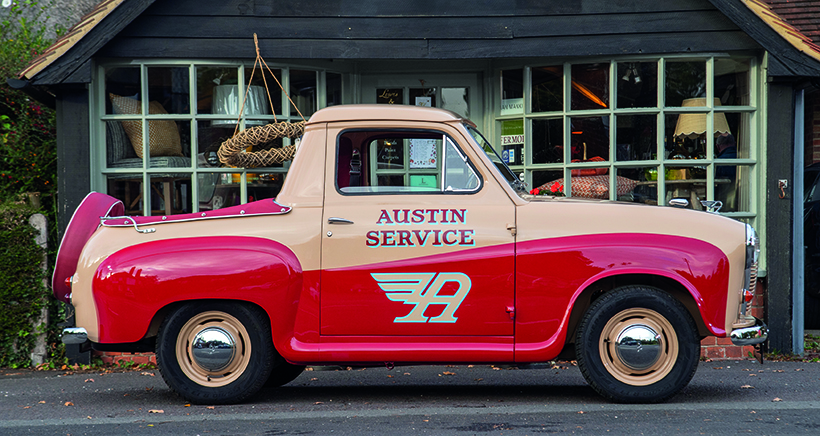
Austin service livery was chosen for this restoration as many pick-ups that dealerships couldn’t sell, ended up being used for internal work by the garages concerned.
Sales rivalry
Austin and Morris were both part of BMC, even though many within the dealerships tried to ignore the fact that the 1952 merger ever happened, and separate dealer networks for each marque still existed. This wasn’t a massive surprise in one respect, as Austin and Morris both had huge networks at the time of the merger, and some quite small towns had separate dealerships for both and these, at a local level, were direct competitors and couldn’t accept selling the exact-same vehicles as the other firm in town.
So, although the Morris Minor was a product of the same company, and also available in van and pick-up form, only BMC dealers with a Morris franchise could sell it! Maybe Austin had, with the pick-up, successfully predicted the sports utility pick-up market, half a century ahead of time? Even the spare wheel resided in its own container, attached to the back of the vehicle.
The new Austin certainly looked the part, and perhaps another potential market was rather upmarket organisations who wouldn’t want to be seen shifting their products in a mere van, and would very much appreciate the 40mpg on offer. Strangely, the seats featured white piping, a luxury not even afforded to A35 owners, further suggesting upmarket aspirations.
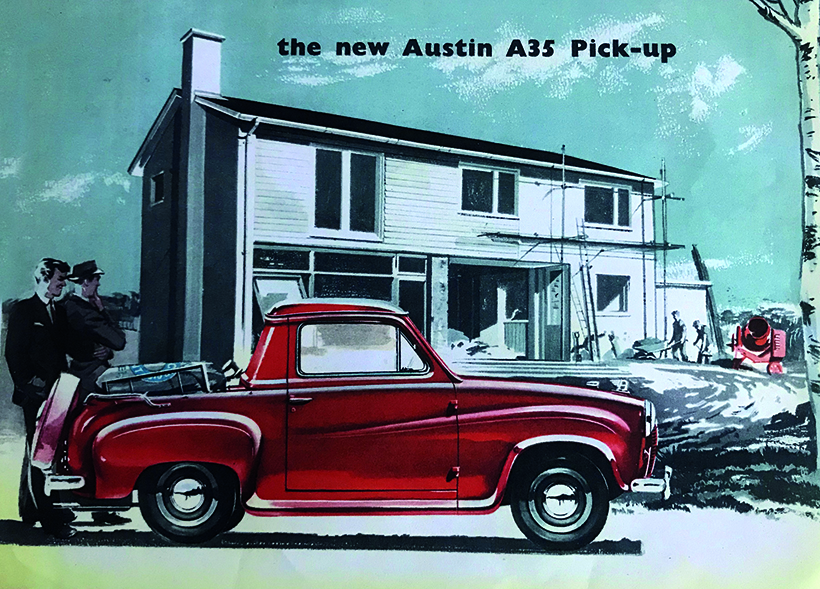
‘Are you sure that bag of cement isn’t going to fall out?’ Great period artwork, but it can’t hide pick-up’s lack of carrying capacity.
Why no tailgate?
But, even with all this madness, one factor stands out. Why on earth was the vehicle not fitted with… a tailgate? Everything (and that’s not a lot!) you put in the back had to be lifted in and out. We know hindsight is a wonderful thing, but just what were they thinking of?
Maybe a rare, historic document can help; an original brochure kindly made available to us by Harry. This features a main cover image of a rather nice, detached house (only one chimney so it must have central heating) under construction, with an A35 pick-up in the foreground. Even allowing for artistic licence, the sack of cement in the back looks a little precarious. Of particular hilarity is the sight of two, Brylcreem-haired young gentlemen perched precariously in the back of the vehicle, sporting expressions combining fear and unfettered embarrassment!
The vehicle’s wooden floor area incorporated two flaps which could be adjusted to make what, according to the brochure, was ‘a temporary seat for two people – an ideal arrangement for switching labour quickly from one spot to another.’ That was if they didn’t jump out and run away en route, presumably. Hmmm, perhaps an A35 car, with a relatively comfortable back seat and potentially even a heater, might have fulfilled this role better.
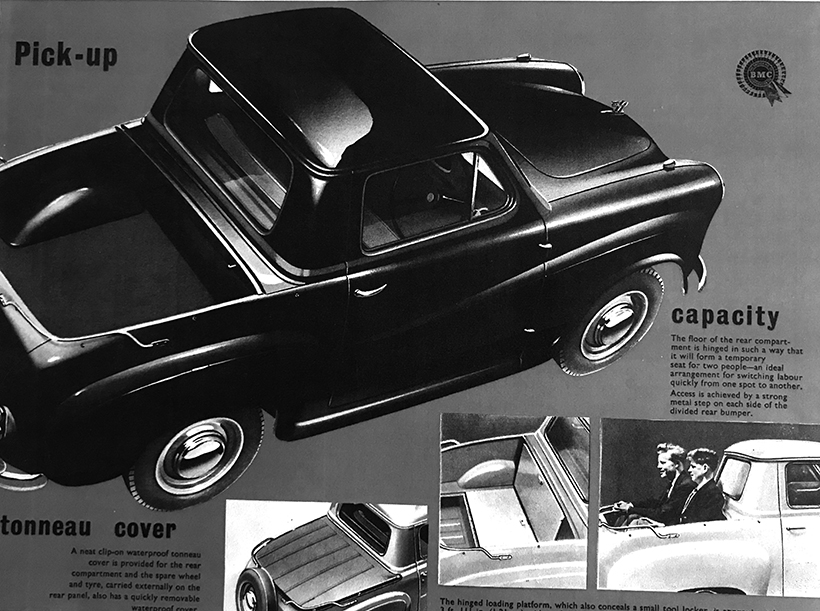
‘Ere guv we thought when you said you were gonna photograph us for an open-top Austin brochure, it’d be a Healey 100/4!’
Limited storage
Grab handles were provided along with a small step, which looks as if it would give way the second a hobnail boot was applied to it. The loading platform also contained a small locker for tools, opened using a T-key stored inside the vehicle, in a pouch by the driver’s right foot. The brochure claims ‘internal capacity’ of about 15cu.ft against a 60cu.ft load capability quoted for the van. It’s no wonder the A35 pick-up didn’t create a sales sensation.
Any efforts to make it look like a car rather backfired, as HM Revenue and Customs almost immediately decided the A35 wasn’t a commercial vehicle as it couldn’t carry enough and was, therefore, liable to Purchase Tax, which commercial vehicles were not. This made it very expensive; the pick-up’s £584 list price was £151 more than a Morris Minor pick-up, and £162 more than an A35 van. Unsurprisingly, this killed sales.

Not a lot of payload-space and no tailgate, either. So, one can sort-of understand why HMRC wouldn’t classify the A35 pick-up as a commercial vehicle.
Just 497 pick-ups were produced before production ceased in 1957. Many were exported to Australia and New Zealand and (we are talking relative terms here), there was some demand from, of all places, Chile. Many UK examples, however, simply hung around, unsold and unwanted in showrooms, some becoming garage hacks.
Yet, somewhat surprisingly, the pick-up has a good survival rate, with 91 examples known to still exist, of which 45 are in Britain. That’s around 20% and, numerically, there are more pick-ups in existence than genuine A35 Countrymen.
The restoration
Harry Douglas has been a big fan of the Austin A30/A35 in all its forms since, at the age of 10, he began going on trips in his uncle’s Spruce Green van. “We used to travel miles and it stuck with me,” recalled Harry, who joined the Austin A30-A35 Owners Club in 1996, and started building up a collection. This includes a 1967 van in rose taupe and yellow rural patrol vehicle guise, which is a replica of a vehicle used by Wiltshire Police. Harry’s wife, Sue, also acquired a 1957 saloon, and Harry added a 1958 van to his collection.
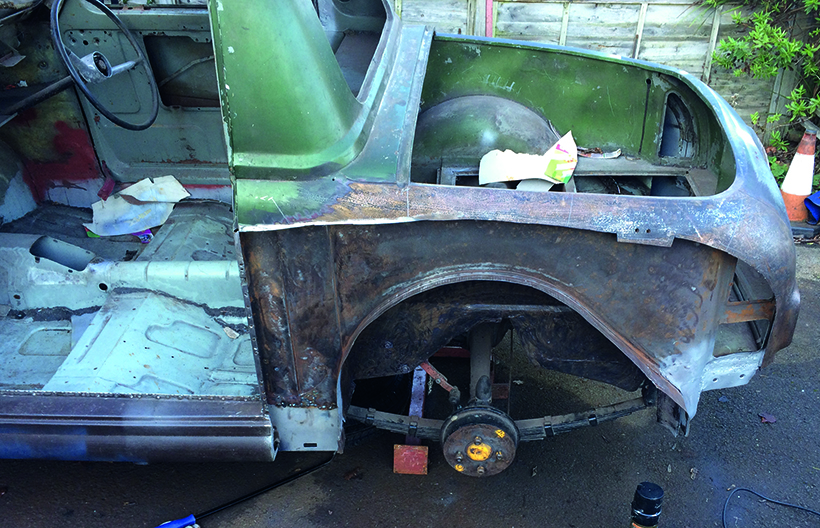
Much-modified rear wings removed.
The pick-up purchase resulted from Harry being one of the exhibitors at a National Exhibition Centre, Birmingham, Classic Motor Show. “A gentleman called Richard Webber came on to the stand and said he’d had a pick-up for many years, and even grass-raced it in the 1970s!”, Harry recalled.
As a result, the wheelaches had been flared out, racing seatbelts fitted and much filler had been used. It was up to 2in thick in places around the rear wheelarches. Harry decided to buy the vehicle, which had been worked on as a ‘fill-in’ by a local garage to MoT standard, but was very much not to original spec.

Rear wings from a standard A35 were adapted, and new wheelarches formed.
The original plan was to have the work done professionally, but there was a snag. “I went to half a dozen specialists, but none of them would touch it. It was a bit outside my comfort zone, but I had no alternative but to tackle it myself.” Harry was able to borrow a complete pick–up side panel which helped him recreate replacement section for his vehicle.
“Due to the flared rear arches, and the butchering that had been done, I had no option but to cut the side out from the B post to just below the rear lights. I made the replacement panel from two saloon panels, welding them together, and changing the wheelarch to a suitable shape using a wooden hammer form.”
Structural repairs
The outer and inner sills had to be renewed, as did the floor from the rear wheels, forwards. Strangely, the rest of the floor was in good order, and five of the seven wooden sections forming the wooden floor of the loading area could be re-used.
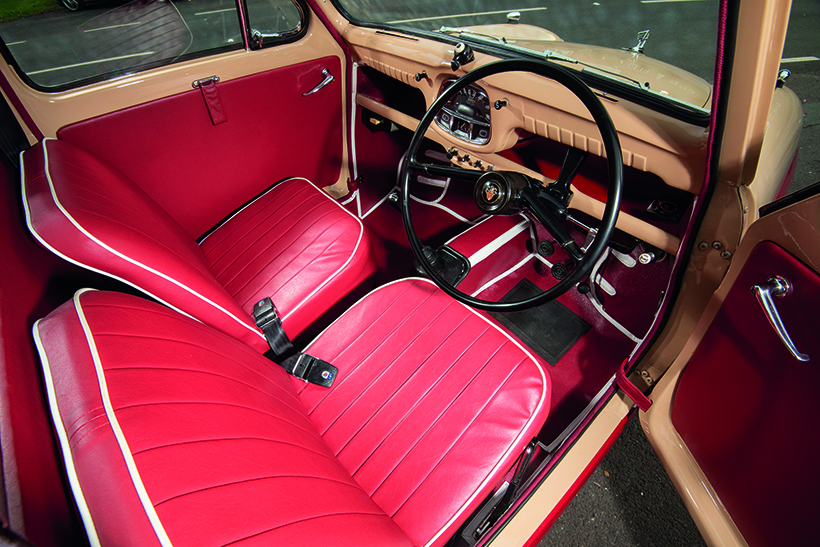
A major production benefit of a central speedo/instrument panel, is that production of LHD and RHD versions is a lot more straightforward; a big benefit with low-cost vehicles like the A35 range.
The seatbelt anchoring points took several days to remove and return to original specification. New front wings (the same as on the van), were fitted and finally the body was ready to be resprayed in stone grey and claret two-pack, by Chris Dolby-Butler of Avenue Autobody, in Berkshire. Signwriting was carried out by Gerald Whittaker.
The grab rails were re-chromed as original, and new tonneau and spare wheel covers were produced by club member, Pete Norbury and others. The headlining, firmly attached by various metal hoops, was a ‘nightmare’ to replace but, incredibly, Harry managed to find a tin containing the original material – unique to the pick-up – at Beaulieu. “It cost £2.50!”
The seats, which had come from a van, were re-upholstered. The engine was rebuilt by owners club member David Clark, with assistance from Harry. The suspension and brakes were all stripped, and a new wiring loom fitted.
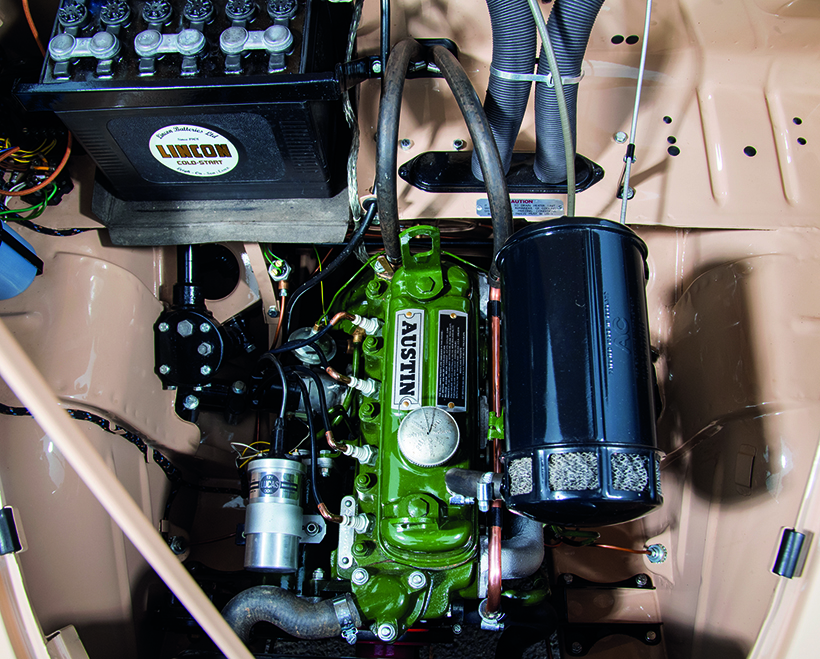
The A35’s A30 predecessor was the first vehicle to be powered by BMC’s legendary A-Series, and with the A35 its capacity increased from 803 to 948cc
And finally…
At last the vehicle was ready to take to the road and start grabbing attention. “There are people who insist I made the pick-up myself from a saloon. A lot of people have never heard of these vehicles,” Harry revealed. However, history shows that this vehicle, 760 BJH, left Longbridge on December 10th, 1956, destined for the Enfield dealership, DJ Shepherd & Co. It was eventually sold to an owner in Berkhamsted, Hertfordshire.
Harry spent two years of intensive effort, over a nine-year period, putting the pick-up back to rights. “I had just started a van restoration when I got the pick-up, and I don’t like to work on more than one restoration at a time,” he said.
Talking of other projects, there has been another recent addition to the Douglas fleet in the form of, would you believe, another A35 pick-up. “It’s come from Chile – and I had to rely a lot on trust to get it transported back to Britain,” said Harry. Although most pick-ups were finished in grey, a few – mainly the exports – were in other colours, including Speedwell Blue and, in the case of this one, Spruce Green, just like the van owned by Harry’s uncle, that opened his eyes to A35s – a lot has happened since then!
To many, including Harry himself, despite its cuddly appearance, his now restored pick-up will forever be known as ‘The Beast,’ a legend carefully sign-written on its bodywork. “The pick-up was so ugly when I got it, and the restoration so major, that I started referring to it by that name, and it’s just sort of stuck ever since.” Maybe it’s a case of Beauty and the Beast!
For a money-saving subscription to Classic & Vintage Commercials magazine, simply click here



